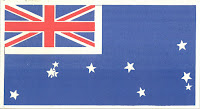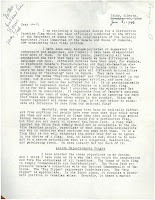While looking through the Stefansson Correspondence collection, we discovered an earlier proposal
for an official Canadian flag. In a letter written in January 8th, 1946, to Vilhjalmur Stefansson, an Allen Ronaghan of Islay, Alberta, suggests a different design to solve the "vital problem" of the lack of a distinctive national flag. Instead of using the Red Ensign flag, which he claims is racist because its coat of arms excludes numerous people groups, Ronaghan recommends instead a flag, presumably of his own design. Ronaghan's flag represents the theme of "Commonwealth and Confederation" and so stands in opposition to other flags which raise objectionable points, in his mind. His flag retains the Union Jack symbol in the upper left corner because, as he puts it, "A flag that ignored the Union Jack simply would not be acceptable to the entire Canadian people, regardless of what some ultra-nationalists may say on occasions when emotions run away with them."
 However, instead of using a coat of arms, Ronaghan recommends the image of Ursa Major on a blue field. The Big Dipper is relevant and appropriate for many reasons, he says, because it's ubiquitous in Canadian skies at night. Also, it bears a "marked resemblance to Canadian confederation," with each star in the constellation representing a different province or territory. Finally, in a tactical move that was doubtless meant to appeal to Stefansson's interests, Ronaghan notes that the Big Dipper "points north" and that Canada must do the same if she is to become "truly great," ostensibly by developing its great stretches of northern wilderness. Stefansson, a world-famous Canadian arctic explorer, appears to be sympathetic to this argument; he has highlighted this portion of Ronaghan's letter.
However, instead of using a coat of arms, Ronaghan recommends the image of Ursa Major on a blue field. The Big Dipper is relevant and appropriate for many reasons, he says, because it's ubiquitous in Canadian skies at night. Also, it bears a "marked resemblance to Canadian confederation," with each star in the constellation representing a different province or territory. Finally, in a tactical move that was doubtless meant to appeal to Stefansson's interests, Ronaghan notes that the Big Dipper "points north" and that Canada must do the same if she is to become "truly great," ostensibly by developing its great stretches of northern wilderness. Stefansson, a world-famous Canadian arctic explorer, appears to be sympathetic to this argument; he has highlighted this portion of Ronaghan's letter.To see Ronaghan's letter and the enclosed pamphlet that outlines the details of his flag design, come to Special Collections and ask to see MSS-196, Box 65, Folder 14, "Ronaghan."


No comments:
Post a Comment